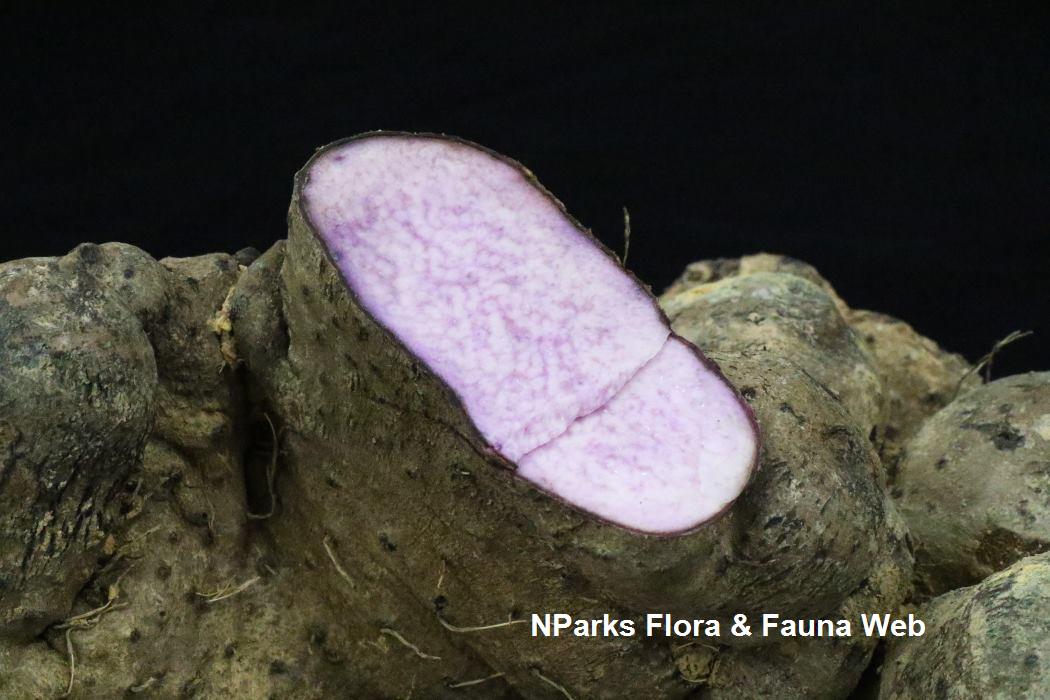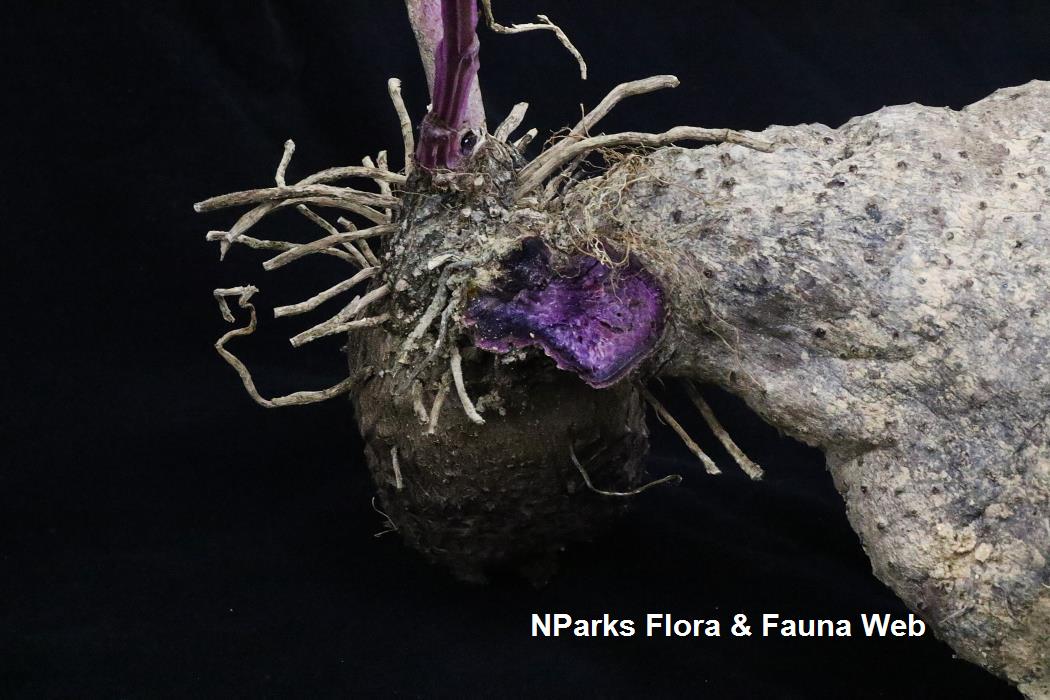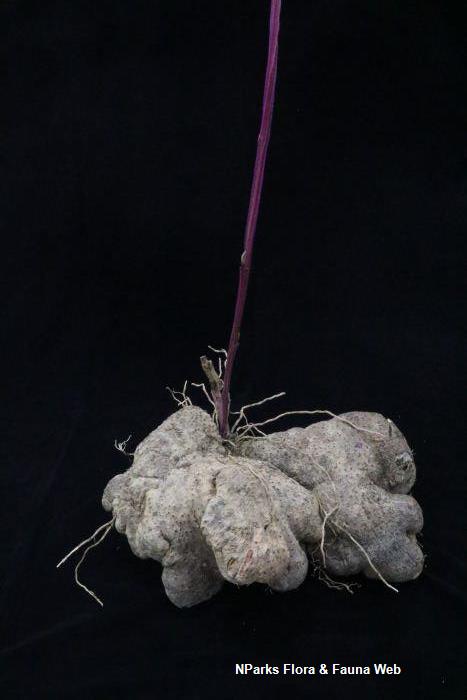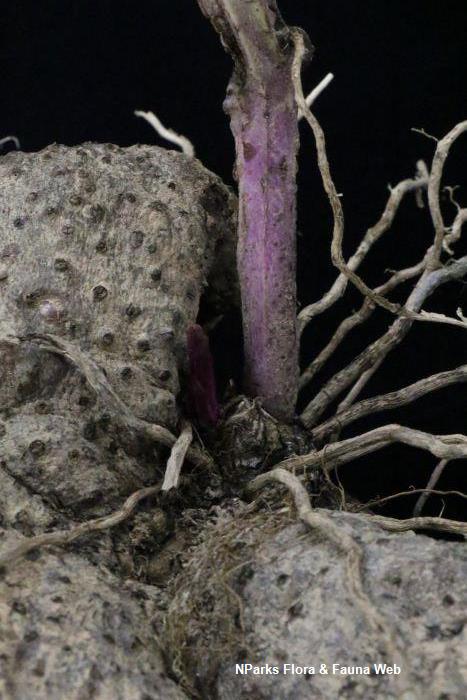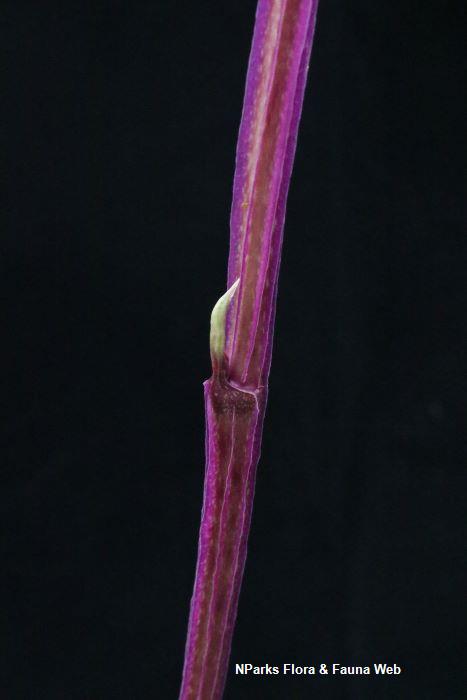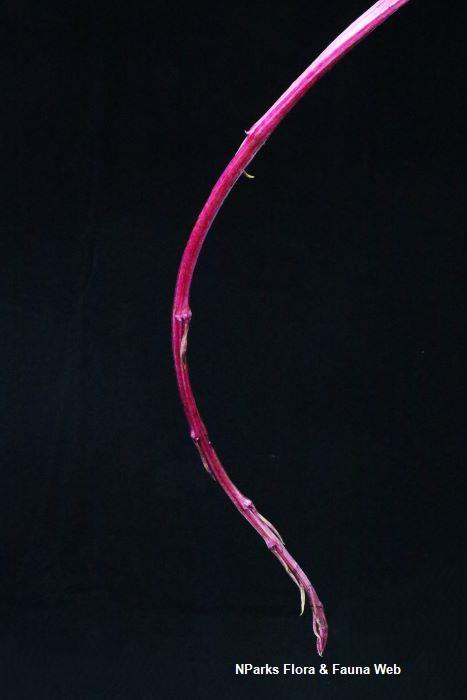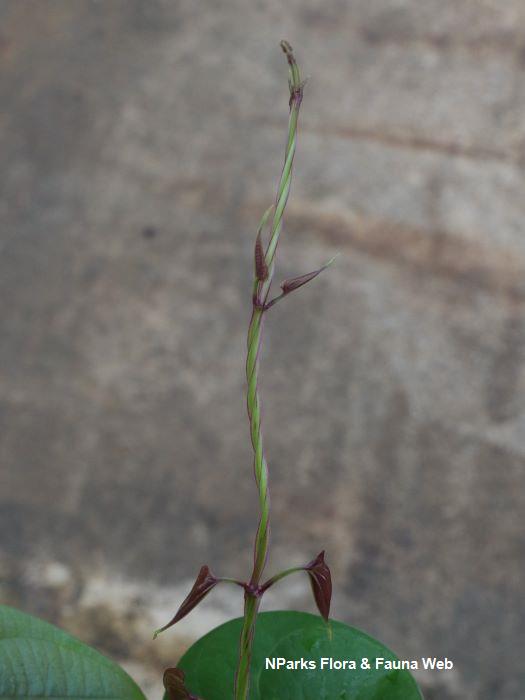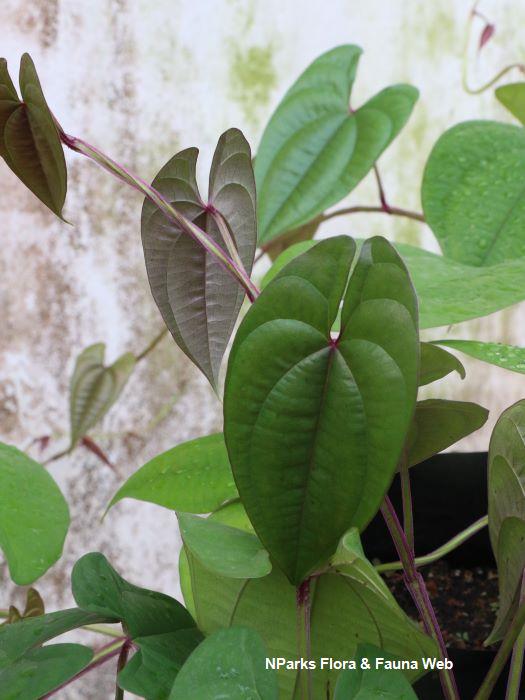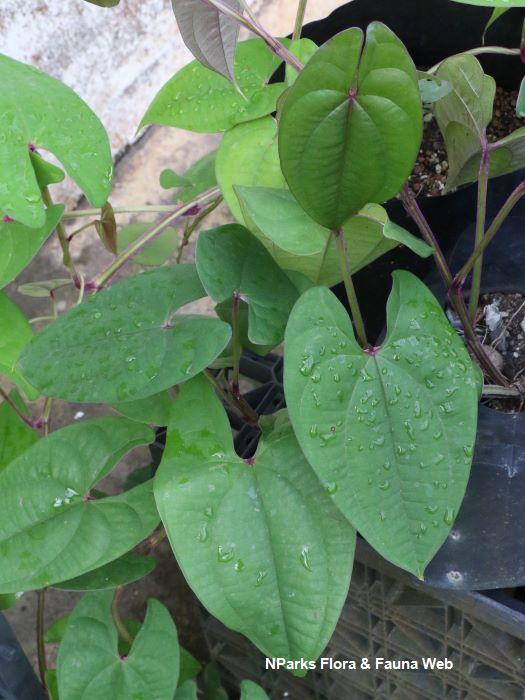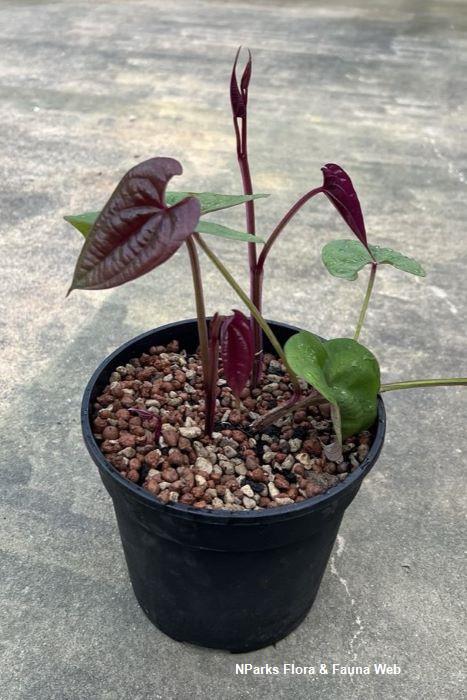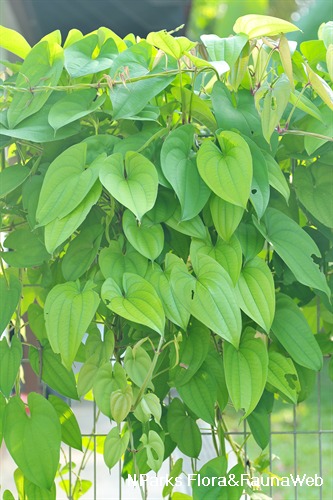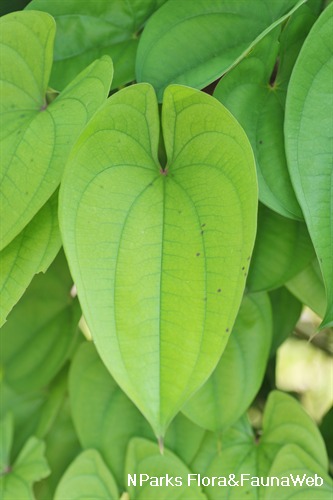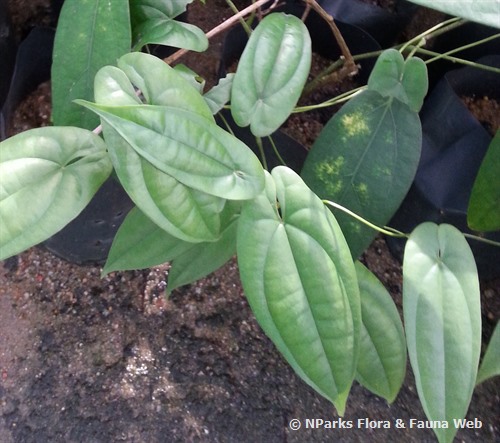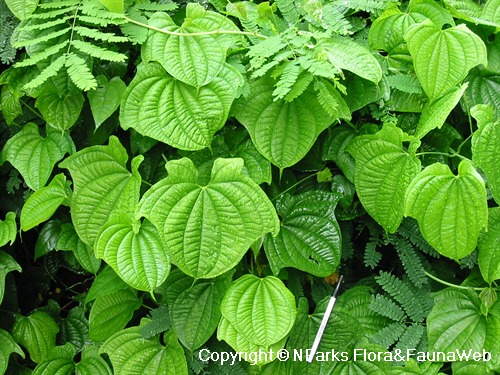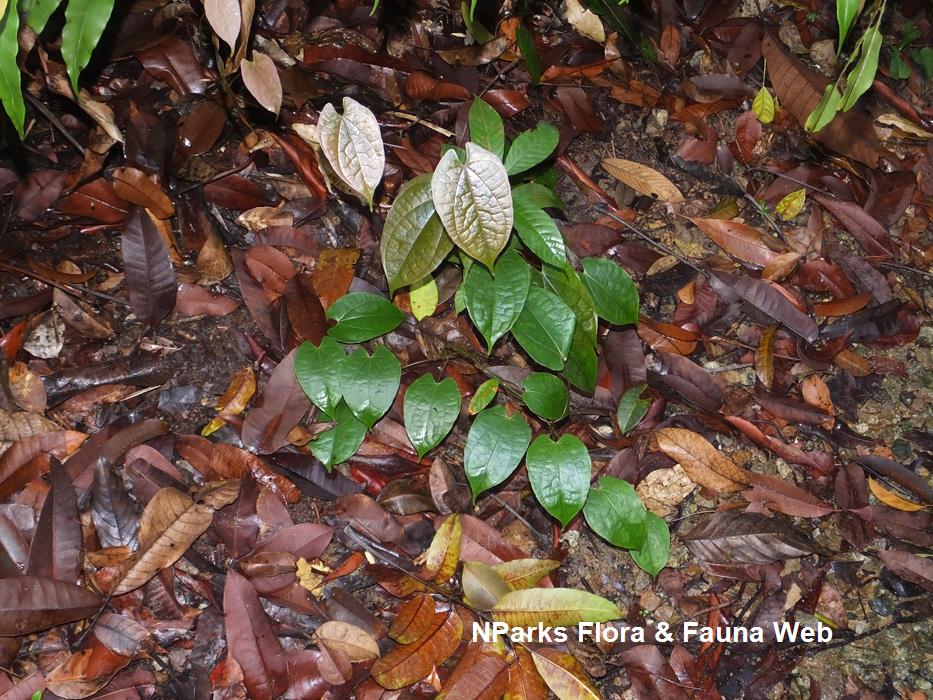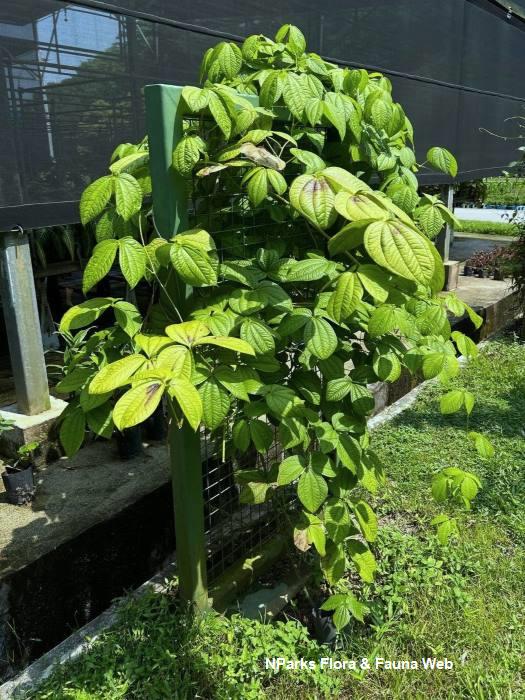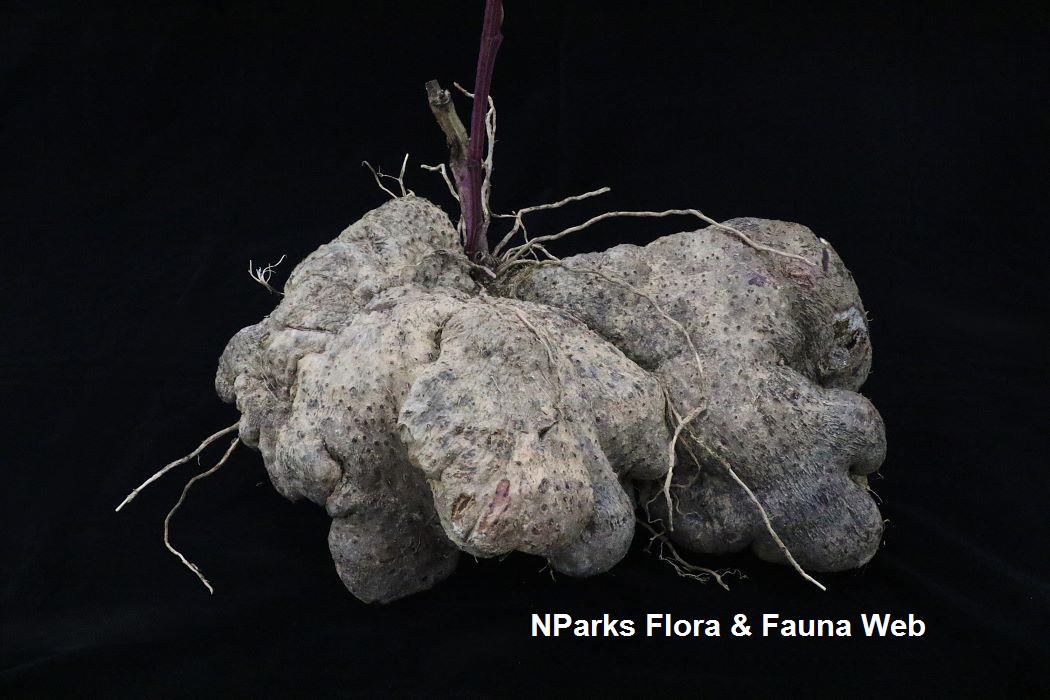
Back
Dioscorea alata L.
| Family Name: | Dioscoreaceae |
| Synonyms: | Dioscorea atropurpurea Roxb., Dioscorea globosa Roxb., Dioscorea javanica Queva, Dioscorea purpurea Roxb., Dioscorea rubella Roxb., Dioscorea sapinii De Wild., Dioscorea vulgaris Miq. |
| Common Name: | Winged Yam, Greater Yam, Water Yam, White Yam, Purple Yam, Violet Yam, Ube, Ubi, |
Dioscorea alata, commonly known as Winged Yam, is a fast-growing climber, named for its winged stems and leaf stalks. It produces underground tubers, which can be white, ivory-coloured or purple. In Thailand and the Philippines, the tubers are widely used in desserts or as an ingredient or flavouring for ice cream, jam and pastries. The purple tubers are often confused with taro or purple sweet potato due to their similar appearance.
Name
Classifications and Characteristics
| Plant Division | Angiosperms (Flowering Seed Plants) (Monocotyledon) |
|---|---|
| Plant Growth Form | Climber |
| Lifespan (in Singapore) | Perennial |
| Mode of Nutrition | Autotrophic |
Biogeography
| Native Distribution | India, Bangladesh, Nepal, East Himalaya, Cambodia, Myanmar, Vietnam, Thailand, Malaysia, Borneo, Philippines, Sumatra, Java, Christmas Island, Lesser Sunda Islands, Sulawesi, New Guinea, Bismarck Archipelago |
|---|---|
| Native Habitat | Terrestrial (Agricultural Land, Monsoon Forest, Disturbed Area / Open Ground) |
| Preferred Climate Zone | Tropical, Sub-Tropical / Monsoonal |
| Local Conservation Status | Non-native (Horticultural / Cultivated Only) |
Description and Ethnobotany
| Growth Form | It is a robust, perennial, herbaceous climber that can reach 20 m in height. |
|---|---|
| Foliage | The leaves are smooth and are arrowhead-like to spear-like in shape, measuring up to 22 cm long and 15cm wide. The leaves are thin, either herbaceous or papery in texture, and have an entire leaf margin. The petioles (leaf stalks) are partially winged. The leaves are arranged alternately near the base and eventually become opposite, then decussate (oppositely arranged, with alternate pairs at right angles). New leaves can be bronze-coloured or purple, eventually turning green with a tinge of purple on the margin and/or petiole. |
| Stems | The stems are smooth, broadly winged and quadrangular in cross-section. The stems climb by twining clockwise up tree trunks or vertical supports. The stems can be green with purple 'wings' or completely purple. |
| Flowers | The inflorescence is a pendulous spike, occurring individually or as a compound spike per node for male inflorescences (up to 30 cm in length) or 1 - 2 spikes per node for female inflorescences (up to 60 m in length). Each inflorescence may hold up to 20 flowers. The flower is imperfect, having six small tepals (petals and tepals that are indistinguishable from one another) with floral bracts, and either male or female reproductive organs. This species is dioecious, meaning male and female inflorescences are borne on separate plants. Most cultivated varieties are sterile and cannot be propagated by seeds. |
| Fruit | The fruit is a capsule (a type of dehiscent dry fruit) with three lobes, each being 17 - 20 mm long by 15 mm wide. Each fruit contains about three winged seeds, one per lobe. |
| Reproductive Parts - non-flowering plant | It produces underground tubers that are deeply buried and vary significantly in shape, with some being elongated, globose, or with lobes. They are brown to black, with white, ivory-coloured or purple flesh. Bulbils are borne along the stems, reaching about 4 cm in diameter. |
| Habitat | It can be found in open, degraded, and disturbed areas, as well as in mixed deciduous forests, pine and hill evergreen forests, at elevations ranging from 0 to 1,250 m above sea level. |
| Taxonomy | This species is considered a cultigen, as its exact origin is unknown. The origins of the purple-fleshed Dioscorea alata supposedly originate from the Philippines. |
| Cultivation | It can be propagated by division, stem tubers, bulbils and rarely seeds. |
| Etymology | The generic epithet Dioscorea is named after Dioscorides Pedanios of Anazarbeus, a 1st Century Greek physician and herbalist who was the author of 'Materia Medica'. The specific epithet alata is Latin for "winged", referring to the winged stems and petioles (leaf stalks). |
| Ethnobotanical Uses | Edible Plant Parts : Edible Storage Organs Food (Fruit or Vegetable): In Thailand, steamed or boiled tubers can be served with coconut and sugar or cooked as a dessert with sugar and coconut milk. In the Philippines, the purple-fleshed tubers are often eaten boiled or baked. Medicinal: Traditional Medicinal Uses: In continental Southeast Asia, the tubers are consumed during recovery from tuberculosis, and kidney and spleen disorders. In Colombia, the leaves are applied as pounded into mash to relieve pimples and tumours, and in baths to relieve various skin irritations and bites from centipedes. The starch from the tuber is applied as a paste to haemorrhoids. In Costa Rica, an infusion of the leaves is drunk to induce sweating, reduce fever and as a digestive stimulant. It is important to note that some therapeutic effects from traditional medicinal uses of plants are not currently supported or verified by scientific research. Others: In the Philippines, the purple-fleshed tubers are used in desserts, such as cake, cheesecake and crinkles, as well as an ingredient or flavour for ice cream, jam and pastries. In Thailand, they are peeled, sliced into small pieces, and washed or soaked in water, then boiled or steamed as an alternative to traditional starch sources. |
Landscaping Features
| Desirable Plant Features | Ornamental Form, Ornamental Stems |
|---|---|
| Landscape Uses | Parks & Gardens, Trellis / Arbour / Pergola |
| Thematic Landscaping | Economic Garden |
| Usage Hazard - Cons | Invasive / Potentially Invasive |
| Usage Hazard - Cons Remarks | Invasive/Potentially Invasive: The plant produces aerial bulbils that may detach and readily grow as new plants. |
Plant Care and Propagation
| Light Preference | Full Sun |
|---|---|
| Water Preference | Moderate Water |
| Plant Growth Rate | Fast |
| Rootzone Tolerance | Acidic (low pH) Soils, Well-Drained Soils, Fertile Loamy Soils |
| Propagation Method | Storage Organ (Stem Tuber), Aerial Bulbil, Division |
Foliar
| Foliage Retention | Evergreen |
|---|---|
| Mature Foliage Colour(s) | Purple, Green |
| Mature Foliage Texture(s) | Papery, Thin, Smooth |
| Prominent Young Flush Colour(s) | Brown, Purple |
| Foliar Type | Simple / Unifoliate |
| Foliar Arrangement Along Stem | Alternate, Opposite |
| Foliar Attachment to Stem | Petiolate |
| Foliar Shape(s) | Non-Palm Foliage (Hastate, Ovate, Sagittate) |
| Foliar Venation | Pinnate / Net |
| Foliar Margin | Entire |
| Foliar Apex - Tip | Acuminate |
| Foliar Base | Cordate, Sagittate, Auriculate, Truncate / Square |
Non - Foliar and Storage
| Stem Type & Modification | Climbing Tendril |
|---|---|
| Root Type | Underground (Fibrous Root) |
| Specialised Storage Organ(s) | Underground (Stem Tuber) |
Floral (Angiosperm)
| Flower & Plant Sexuality | Unisexual Flowers , Dioecious |
| Flower Colour(s) | Green, Yellow / Golden |
|---|
| Flower Grouping | Cluster / Inflorescence |
| Flower Location | Axillary |
| Inflorescence Type | Spikelet / Pseudospikelet / Compound Spike, Spike |
| Ovary Position | Inferior / Epipgynous |
| Flowering Habit | Polycarpic |
Fruit, Seed and Spore
| Mature Fruit Colour(s) | Brown |
|---|---|
| Mature Fruit Texture(s) | Papery |
| Fruit Classification | Simple Fruit |
| Fruit Type | |
| Seed Quantity Per Fruit | Few (1-5) |
References
| References | <1> Burkill, I.H. (1951). Dioscoreaceae. In: Van Steenis, C.G.G.J. (ed) Flora Malesiana, Ser. 1, Seed Plants, Vol. 4: 293–335. Leiden: Noordhoff. <2> Chung, R.C.K. (2001). Dioscorea L. In: van Valkenburg, J.L.C.H. and Bunyapraphatsara, N. (Editors): Plant Resources of South-East Asia No 12(2): Medicinal and poisonous plants 2. PROSEA Foundation, Bogor, Indonesia. <3> 1. Dioscorea alata L. e-Flora of Thailand. https://botany.dnp.go.th/eflora/floraSpecies.html?tdcode=04110 (Accessed 26 September 2025) |
|---|
Image Repository
Others
| Master ID | 31656 |
|---|---|
| Species ID | 6055 |
| Flora Disclaimer | The information in this website has been compiled from reliable sources, such as reference works on medicinal plants. It is not a substitute for medical advice or treatment and NParks does not purport to provide any medical advice. Readers should always consult his/her physician before using or consuming a plant for medicinal purposes. |

